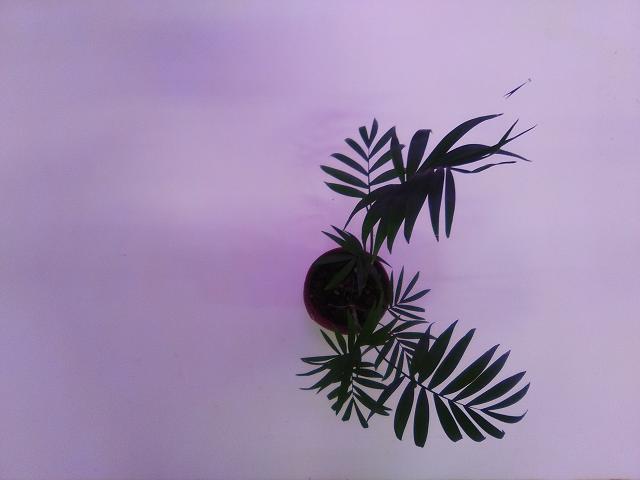This project started in September 2016, when Vidal bought the entire stock of a plant store in Barcelona. His goal was to measure the variations and interactions of more than 300 plants, evaluating, among other factors, their surface, volume, color, humidity, and light. Vidal soon realized that he required a watering schedule for each plant. He developed his research in collaboration with his colleagues at the optics group in the physics department at the Autonomous University of Barcelona. By using lasers to measure the cells' composition and the water accumulation in leaves, Vidal and his colleagues are developing a methodology with several potential applications, from the early detection of diseases to sustainable agricultural systems. This research is currently being developed in partnership with other institutions, including the Botanical Institute of Barcelona. The team will soon publish the results in various scientific journals.
Now, a new phase of Vidal’s project will be presented at the Abrons. This starts off with the idea of importing all plants to the United States, showcasing elements of the research through artistic and scientific inquiries. While some of the plants will be included at the exhibition at ADN Gallery in Barcelona, others will travel to the United States. This has prompted a broad effort to process all the required paperwork through the usual bureaucratic procedures under the US Department of Agriculture and their Spanish counterparts. The fate of this process remains uncertain, as there are multiple factors that could potentially disrupt the plants' travels. In fact, there are many agents and steps that could make it impossible for the plants to arrive to the United States--both biological and legal restrictions. This branch of the project points at a system of intricate relations between entities that conform a globalized networked of mobility and transportation. Airplanes, phytosanitary certificates, e-mails, cardboard boxes, government officials, plant species, and the streets of Barcelona and New York are connected in an entanglement that is activated in this project. Vidal's interest in systems and their performance works with artistic attention to networks and their fluctuation.
In addition, the exhibition presents a series of drawings made by Pep Vidal during his residency in Croatia. These employ scientific graphic principals in artistic configurations and serve as citations for the conceptual interests that resonate in the project, mainly occupying systems representations and the borders of entities. The drawings are embedded in a grid that transforms the gallery into a measuring chamber, where each wall works as a calculation plane: x, y, and z. Here, the overall concern of the project with systems and measurements is not only depicted but also enacted as the gallery becomes a scientific tool. Other elements, such as a homemade perfume using dead flowers from the plants, and legal documents that detail all the information relevant to the transportation of plants into the United States, are also included in the exhibition.
One of the aims of the project is to provide a more accurate system of measurements, something that mobilizes the artistic and scientific fields towards a questioning of human perspectives. Historically, exploitation has been associated with a model of economic profit based on a visual organization of the world, such as lineal perspective. The quest for a different approach to elements and entities suggests proximity to the object of study that could potentially be directed towards other models of production, economic development, and knowledge. By artistically addressing these concerns, the artist mobilizes a set of preoccupations that consider the variability of matter and the systemic circumstances of any entity, either human or non-human.
On Wednesday, December 13, at 6.30 p.m., Dr. Diana Reese, Professor of comparative literature with an emphasis on German and French 18th Century literature and philosophy, will join Pep Vidal and Xavier Acarín in a conversation about the project.
About the Artist:
Pep Vidal (Barcelona, 1980). Degree in Mathematics at Universitat Autònoma of Barcelona (UAB) (2008). Special interest in infinitesimal calculus, topology, and infinite series. PhD in Physics in UAB and ALBA synchrotron (2014). Thesis research about mathematical algorithms for improving accuracy of instruments used in particle accelerators. I have two important conclusions from here: there are some extremely sensitive and complex systems; and I’m not interested in research that doesn’t include my own experience and vital life in the process. Advanced course in Contemporary Art in A*Desk (2011-12), conducted by David Armengol. Resident artist at Hangar, Barcelona, 2013-15, FARE, Milano, 2013 and Casa de Velázquez, Madrid, 2014. Residencies: Hangar, Barcelona, 2013-2015; FARE, Milano, Oct-Dec 2013; Casa Velázquez, Oct-Dec 2014. Grants and prizes: International Visual Arts Grant Fundación Botín 2016-17, Propuestas 2014 VEGAP (Visual Arts), Generaciones 2015, Miguel Casablancas 2014, ICUB La Capella 2013. Solo shows at ADN Gallery (2015, Barcelona), Rolando Anselmi Gallery (2015, Berlin), Capella de Sant Roc (2015, Valls), Art-O-Rama (2014, Marsella), L21 Gallery (2014, Madrid), Sal´on (2013, Madrid), Espai Cub La Capella (2013, Barcelona). Last group shows in L21 Gallery (Madrid, 2016), Antoni Tàpies Foundation (curated by Oriol Fontdevila, 2015), Caixaforum Barcelona (curated by Juan Canela, 2015), VII Bienal de Jafre (curated by Carolina Grau Rahola, 2015), Fabbrica del Vapore, EXPO 2015, Generaciones 2015, La Casa Encendida, Madrid and Lisboa, 2015, OTR (curated by Carolina Castro, 2015). Colletion: Anny De Decker private colletion, Antwerpen; Francisco Cantos private colletion, Madrid; Urbano private colletion , Madrid; Montemadrid Foundation, Madrid; Arxiu del Centre d’Estudis i Documentació del MACBA, Barcelona; Centro de Documentación y Biblioteca del MNCARS, Madrid; Museum of Modern Art Library, New York.
This project has received the support of Institut Ramon Llull.






